Jun 2011
Carol Anne Costabile-Heming
The Stasi on Display in Berlin: The Role of the Museum in the GDR’s Contested Legacy[1]
Memory always reflects the interests and experiences of those doing the remembering.–Rudy Koshar (199)
Introduction
In the 20 years since the fall of the Berlin Wall, scholars and critics repeatedly have debated the ways in which the GDR past can be explained, commemorated or preserved. Although popular films such as Sonnenallee (1999) and Goodbye Lenin! (2003) fueled a wave of Ostalgie in the form of Spreewaldgurken and other consumer goods, the legacy of the GDR’s cultural and political institutions is more contested. The international acclaim, which the academy award winning film, Das Leben der Anderen (2006), received, brought the controversial legacy of the Ministerium für Staatssicherheit (MfS or Stasi) in the GDR into the international limelight. While Florian Henckel von Donnersmarck’s film presents the details of Stasi interrogations and surveillance in a realistic way, the depiction of the main character Hauptmann Wiesler as a positive hero misrepresents career officers in the Stasi and in so doing devalues the very real trauma that dissidents under surveillance suffered. The film’s opening shots depict an interrogation in a detention center, a setting made to look like the Hohenschönhausen prison, even though the Gedenkstätte director, Hubertus Knabe, denied von Donnersmarck permission to film on location because he believed the screenplay falsified the history of the site. Because of such ambiguity, the film simultaneously received critical acclaim for its cinematic techniques and harsh criticism for its lack of historical authenticity.[2]
Such questions of historical authenticity are at the heart of debates about the film, to which scholars have had a decidedly different reaction than the popular media. In 2008, the German Studies Review devoted a portion of one volume to the film, in which scholars addressed both the film’s popularity as well as its problematic portrayal of the Stasi. Thomas Lindenberger, for instance, examines the film’s two-fold authenticity, namely its ability to give those unfamiliar with the GDR and its secret police organization a sense of what the surveillance system entailed as well as the way in which the film has distanced itself from other movies about the GDR such as Sonnenallee and Goodbye Lenin! Conversely, Mary Beth Stein claims that the film perpetuates misconceptions about the GDR and the Stasi, and she suggests that the focus on Wiesler’s motivations makes the film more readily accessible to foreign audiences (568 and 570). Indeed, someone who knows nothing of the surveillance system in the GDR can leave the theater following a viewing of the film with the feeling of being an expert.[3] Jens Gieseke criticizes the film’s lack of authenticity, noting that it provides clues about the current discourse of dealing with the past without actually dealing with that past (“Stasi Goes to Hollywood”). On the other hand, Manfred Wilke, well known for his work as a consultant with the Enquete Commission and as co-director of the Forschungsverbund SED-Staat, who also served as a consultant to the film, surprisingly considers the portrayals believable.[4] Further confusing the issue of authenticity, Roman Grafe argues, is von Donnersmarck’s overlay of dates, places and newspaper titles, which serve to confuse the viewer and lend a documentary air to an entertainment film. Grafe criticizes the film quite strongly, chastising critics who reacted positively to it. For him, the positive response sets up a dangerous precedent, enabling perpetrators to view themselves as good people and abdicate their complicity (183). Indeed, Jens Gieseke warns that the Stasi and IMs are turning into “Erinnerungsorte,” thereby becoming icons in the film. Such media images slowly erode actual memories (“Die Stasi und ihr IM” 107).
Public and media fascination with the Stasi has not waned. In May 2009 Die Zeit published an article entitled “Wir haben uns alle geirrt” revealing that the police officer who shot and killed student Benno Ohnesorg in 1967 was, in fact, a Stasi operative. Such sensationalist reports underscore the divide between real life accounts and the depiction of the Stasi on the big screen or in the media. This disparity begs the question as to how the Stasi as an artifact objectively can be commemorated or preserved. What message do we learn from the Stasi on display? The answer may lie outside the movie theater at the actual sites of Stasi activities.
If we accept Rudy Koshar’s standpoint that “Memory always reflects the interests and experiences of those doing the remembering,” it is easy to understand why the cinematic representations of the Stasi have met with such varied reactions (199). Indeed, the responses to Das Leben der Anderen mirror closely those of other controversial legacies, such as the portrayal of Hitler in Der Untergang (2003/2004) and the depiction of the White Rose resistance group in Sophie Scholl – Die letzten Tage (2005). Unlike an entertainment film, however, a memorial site or museum is an “intermedial genre” (Arnold-de Simine 254), wherein the question of what is displayed, from which perspective, and to what end is of paramount importance.
This essay looks at the context in which the Stasi’s legacy can be understood by examining the preservation and musealization of the Stasi legacy at three museums and Gedenkstätten in Berlin: STASI. Die Ausstellung zur Staatssicherheit, a permanent exhibit under the auspices of the Gauck/Birthler/Jahn Behörde; the Forschungs- und Gedenkstätte Normannenstrasse, which occupies the former Stasi Headquarters, and the Gedenkstätte Hohenschönhausen, a former Stasi remand prison. These sites bring the inner workings of the Stasi into the public sphere, showcase differing perspectives, and thus contribute in numerous ways to the social, cultural and collective memory of the Stasi in united Germany. Each site employs a different framing strategy unique to its particular focus and perspectives on the Stasi, with sponsorship and funding playing crucial roles in their sustainability. Furthermore, their respective interpretation and contextualization of the Stasi’s legacy offers the most fertile ground for understanding the complexity of its commemoration for future generations.[5]
Memory culture(s)
Established on 8 February 1950, the Stasi was modeled on the Soviet KGB and the secret service agencies of the other East Bloc countries. Unlike these surveillance organizations, the Stasi was tied closely to the SED, extending its reach to all corners of society. According to Jens Gieseke, the Stasi’s breadth was due in large part to its fixation on security risks through “Feindeinflüsse,” that could happen at any moment (Mielke-Konzern 102). Such risks could come from within as well as from external forces. For this reason, freedom of expression was closely watched by the Stasi. As David Childs and Richard Popplewell explain, “[t]he pervasiveness of the security organs served to prevent public expression of any thought hostile to the SED line. The very knowledge that they were there and watching served to atomize society, preventing independent discussion in all but the smallest groups” (63). In an effort to control the information to which ordinary citizens had access, the Stasi paid close attention to the cultural sector, particularly following the uprising in Hungary in 1956. Writers and intellectuals also were subjected to more intense scrutiny following the construction of the Berlin Wall in 1961, an event which physically served to limit any external influences. Following the Wall’s construction, the SED feared any dissent that could occur internally. These internal dissidents were different from external enemies, for they were not opposed to the system in place, but rather, sought to reform it from the inside. As a result, these dissidents tried to articulate their positions from within the current discourse. In response, the Stasi established Hauptabteilung XX, responsible for opposing political underground activity and political-ideological diversion, in the spring of 1964. Equally essential to the information gathering system of the Stasi was the network of inoffizieller Mitarbeiter or IM, who infiltrated all types of private and social spheres. By the late 1980s, the MfS employed as many as 91,000 full time officials and another 175,000 unofficial collaborators (Dennis 3).
Memorials dealing with the German past “are fraught with symbolic meaning and become contested terrain” (Dueck 601). Yet, as Maurice Halbwachs wrote, monuments are central to the formation of collective memory. Going a step further, Pierre Nora spoke of “rememoration,” a phenomenon that Koshar describes as “a framing strategy of remembering to remember the past in the present rather than trying to reconstitute past events in all their detail” (284). For Silke Arnold-de Simine this cultural memory “is actively constructed, shaped and handed down by social institutions” (254). Anne Fuchs and Mary Cosgrove choose to speak of memory contests, which are “highly dynamic public engagements with the past that are triggered by an event that is perceived as a massive disturbance of a community’s self-understanding” (2). This characterization is particularly apt in light of the controversy that erupted after the Sabrow Commission made a recommendation to incorporate Alltag or quotidian GDR life in addition to mechanisms of the Gewaltherrschaft in future planning for memorializing the GDR (Wohin treibt die DDR Erinnerung? 17-41). Established in 2005 by the Bundesbeauftragte für Kultur und Medien, this committee of experts comprised of historians, writers and activists was charged with developing the concept for a decentralized organization devoted to coming to terms with the SED dictatorship. The commission’s recommendation proposed that future study and commemoration of the GDR heritage focus on three specific thematic areas: “Herrschaft—Gesellschaft—Widerstand,” “Überwachung und Verfolgung,” and “Teilung und Grenze” (Wohin treibt die DDR Erinnerung? 23). Transmitting adequate commemoration into a museum setting has become the major bone of contention in the representations of the Stasi I discuss here.
As a repository for the past, a museum follows a specific set of criteria as it builds its collection. In analyzing these criteria Andreas Huyssen argues that one must “determine to what extent [the museum] helps overcome the insidious ideology of the superiority of one culture over all others in space and time, to what extent and in what ways it opens itself to other representations, and how it will be able to foreground the problems of representation, narrative, and memory in its designs and exhibits” (34). To be sure, an exhibition becomes something removed from daily life. Museum visitors are detached from the objects on display; this sense of detachment thus distances them from that which is being observed.
Dan Ben-Amos emphasizes the importance of collective memory as a positive force, which “becomes the creative imagination of the past in service of the present and an imagined future” (299). Twenty years beyond the fall of the Wall it has become a crucial time for GDR citizens to “collect” their history, for this act of “collecting” counteracts any fears of forgetting the past. However, because of the GDR specificity of the sites discussed here, it is difficult for them to become a part of the fabric of united Germany’s collective memory, an issue at the heart of debates about public funding for the sites. This makes the act of “collecting memory” all the more difficult, and at the same time, all the more crucial. Furthermore, it makes the examination of how specific museums do this all the more imperative.
STASI. Die Ausstellung zur DDR-Staatssicherheit
Of the three exhibitions and memorials to be discussed here, STASI. Die Ausstellung zur DDR-Staatssicherheit provides the most generalized and contextualized approach for those visitors lacking basic knowledge of the history and activities of the Stasi. Located in the Bildungszentrum des BStU in the vicinity of Checkpoint Charlie, this exhibition, sponsored by the Bundesbeauftragter für die Unterlagen des Staatssicherheitsdienstes der ehemaligen Deutschen Demokratischen Republik is a permanent display open to the public at no charge.[6] In the foreword to the exhibition catalog, Marianne Birthler, the second Federal Commissioner, remarks that the exhibition’s function is to contribute to the contemporary discussions about the coming to terms with GDR history, “um Legendenbildungen und Geschichtslügen entgegenzuwirken” (Stasi. Die Ausstellung zur DDR-Staatssicherheit 5). She posits that the exhibition does more than just inform about the Stasi, for it also can “für die Bedeutung der Menschenrechte sensibilisieren, zur Wertschätzung von Freiheit und Demokratie beitragen und zeigen, wie sehr eine Gesellschaft auf Zivilcourage und bürgerschaftliches Engagement angewiesen ist” (Stasi. Die Ausstellung zur DDR-Staatssicherheit 5). Thus, the exhibition clearly has a mandate to inform about the past so that Germany can come to terms with it and move beyond it.
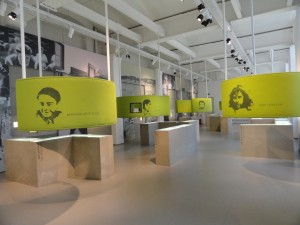
Stasi. Die Ausstellung
This exhibition contains three thematic segments, which include information on the history of the Stasi, examples of the impact of the Stasi on individual biographies, and portrayals of the intersections of the Stasi with everyday life. These three segments are independent of each other, and therefore they can be viewed in any order. It is a small exhibition, whose intent is to allow visitors to draw their own conclusions and connections based on what they observe.
The history of the Stasi is depicted in nine display cabinets: “die Funktion,” “der Apparat,” “die Methoden,” “die Allgegenwart,” “die Hauptamtlichen,” “die Bruderorgane,” “die Westarbeit,” “die Inoffiziellen,” and “das Ende.” A variety of artifacts comprise the display including photographs, facsimile documents, and three dimensional objects such as spy cameras and Geruchskonserven.

Geruchskonserven
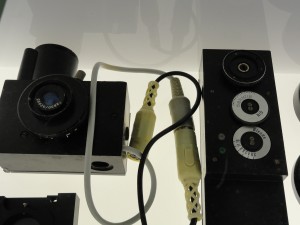
Stasi Spy Camera
Six personal biographies highlight the direct impact that the Stasi had on the lives and careers of ordinary GDR citizens. Hung from the ceiling, the three dimension half rounds that house the documents and artifacts of these individuals showcase the depth and breadth of the Stasi’s reach into the private sphere.[7] The final segment consists of a series of seven wall panels depicting Stasi intrusion into everyday life, including youth, sports, cultural, travel, churches, industry, and the Nationaler Volksarmee. This segment demonstrates quite clearly, that although GDR citizens tried to carve out private lives, the Stasi was intent on gaining as much access as possible.
The overall composition of this exhibition is historical and informative. It documents Stasi activity in all areas of life, from official functions and the military, as well as in the public and private spheres. It serves the purpose of a broad presentation of the Stasi from the beginning of the GDR to its end. Though it is located in Berlin, the displays focus on all geographic areas of the GDR. In terms of a national narrative, this exhibition speaks directly to the laws as set forth in the Stasi Unterlagen Gesetz and conforms to Joachim Gauck’s plea “Sich der Vergangenheit zu stellen,” which he articulated in the official press kit for the first Stasi exhibition (Der Bundesbeauftragte 1).
Though Germany has been unified for more than 20 years, it still struggles to define a national narrative that reflects the experiences of all citizens. Whereas confronting the Nazi past formed the backbone of West German consciousness and self-identity for nearly 45 year (up to the fall of the Wall), the GDR’s self-representation as an anti-fascist state informed its relationship to the Nazi past. For citizens of the former East, it remains the legacy of the Stasi’s surveillance and repression that still needs to be addressed and incorporated into a national narrative. To this day there still is a lack of understanding on the part of many Westerners about the Stasi surveillance system and its importance in the lives of former GDR residents, and this exhibit therefore fills an important educational role.
Forschungs- und Gedenkstätte Normannenstraße
While STASI. Die Ausstellung zur Staatssicherheit is an officially commissioned and supported site, the other two sites to be discussed here grew out of grass roots initiatives to preserve the legacy of the Stasi for future generations. The Forschungs- und Gedänkstätte Normannenstraße is located in Haus 1 of the Stasi’s central headquarters in Berlin-Lichtenberg, a site that Frank König terms the most important perpetrator site of GDR history (253).[8] The entire region has gained in popularity as a tourist site, evidenced by the 2009 publication of a guidebook entitled Stasi-Stadt. Die MfS-Zentrale in Berlin-Lichtenberg. Ein historischer Rundgang by the Christoph Links Verlag.

Stasi Head Quarter Haus 1
Opened to the public on 7 November 1990, the Forschungs- und Gedenkstätte Normannenstraße is an outgrowth of a grass roots movement formed by civil rights activists under the name Antistalinistische Aktion Berlin-Normannenstraße (ASTAK) (Verheyen 156 and König 207-23). The idea to create a memorial site here dates to the days immediately following the storming of the building on 15 January 1990. The two-pronged focus serves to guide attention to both memory and research. ASTAK advocated not only for the creation of the permanent exhibition, but also directed its efforts toward the documentation of and research into all aspects of Stasi activity, as well as the creation of forums for discussion and for the support of victims.
Financial difficulties plagued the early years of the site, and in 1993, the Berlin Senate Committee for Cultural Affairs decreed that the center should operate under the auspices of the Federal Commission for the Stasi Files. ASTAK members resoundingly rejected this proposal, operating the museum on a volunteer basis for a six-month period. In subsequent years, funds from the Berliner Landesbeauftragten für die Stasi-Unterlagen and the Stiftung zur Aufarbeitung der SED-Diktatur provided financial support for the continued operation of the museum. The main parts of the exhibition focus on Stasi memorabilia, observation equipment, and the office of Stasi chief Erich Mielke.
The entry foyer contains original artifacts including a series of flags and statues that were housed there during Stasi times.

Stasi Memorabilia
The collection of memorabilia draws attention to the traditions that formed the core of the Stasi’s self-definition, including relics exchanged between the Stasi and the KGB, which are displayed in glass curios, as are beer glasses with the Dynamo emblem, the Stasi-sponsored soccer club. The Ministry’s main office complex is housed here, and Mielke’s office and private rooms are preserved in their original condition.
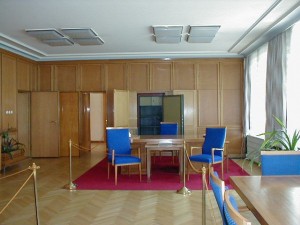
Stasi Office

Erich Mielke's Office
Dirk Verheyen remarks that “visitors were generally struck by the banality of Mielke’s offices, the petty-bourgeois decorative taste that accompanied [Mielke’s] security paranoia […]. No sophisticated, high-tech equipment, but old typewriters and telephones” (157-8). Thus, these rooms present an inside look at the innermost and quotidian workings of the secret police. As Christian Halbrock notes, this was an “Ort der Repression” (31). On an additional floor, displays document both surveillance and opposition in the period from 1945 to 1989. A special permanent exhibition documents the fate of the Jehovah’s Witnesses in the GDR. Immediately following the end of World War II in 1945, Jehovah’s Witnesses were granted official status as “Opfer des Faschismus.” East German authorities grew increasingly suspicious of the group’s political neutrality, banning their beliefs in 1950. This unleashed a wave of persecutions at the hands of the Stasi.[9]
Like “STASI. Die Ausstellung zur Staatssicherheit,” this museum grants visitors insight into the various operations that the Stasi had under its control. Because it occupies the original offices, it can foreground the Stasi’s image of itself. Visitors with a good understanding of the Stasi can find this site-specific museum an emotional experience. [10] This was particularly true in the beginning, when most visitors were GDR citizens, curious and anxious to get a glimpse at the organization that had terrorized their society for so many years. In just three months during 1990, 9,000 people visited the site (Verheyen 158). According to König, nearly 70,000 visitors on average tour the site each year (König 207).
The financial struggle that this site has endured sheds light on the tenuous position that Stasi-specific sites occupy within the memory landscape of united Germany. Often supported through private initiatives, federal funding has been more tenuous. Because many of the decision makers at the federal level are from the West, they therefore have no real stake in the survival of institutions dedicated to preserving and educating about the GDR. In general, the memory landscape in Germany is fraught with political jockeying for positioning and validation. As Frank König remarks about the case of Normannenstraße: “Es geht um die Durchsetzung von Geschichtsbildern, um die Konkurrenz zwischen erlebten Geschichten und gemachten Erfahrungen sowie wissenschaftlicher, nüchterner Expertise und pädagogischen Zielvorstellungen: Überspitzt gesagt Emotion gegen Kognition” (309).
ASTAK emphasizes heavily the site’s function as one of political education, a standpoint that some view with skepticism. Verheyen, for instance, proposes that “ASTAK prefers a confrontation (Auseinandersetzung) with the East German past that is offensiv and kritisch, yet fears that the official approach tends toward increased disinterest and/or post facto manipulation of memory and interpretation” (162). Conversely, Halbrock emphasizes the authenticity of the location and the grass roots movement that made the site possible (31). The publication of a guided walking tour adds an additional dimension to this site for it foregrounds both the enormity of the Stasi operations in Berlin as well as the way in which the presence of the Stasi served to alter this once idyllic neighborhood, as streets disappeared and new structures were built specifically to serve the needs of the Stasi.[11]
The Gedenkstätte brings two very different focal points to the forefront, depicting very clearly the complexity of the Stasi legacy within the larger framework of a national memory narrative. On the one hand, this is a perpetrator site, and its preservation foregrounds the Stasi’s Selbstbild and special status. The entire complex testifies to the Stasi’s magnitude, and the way in which it availed itself of city planners and city resources to take over an entire neighborhood. On the other hand, the site also strives to commemorate those people who had fallen victim to Stasi terror. This dichotomy between perpetrator and victim, preservation and commemoration contributes to the tensions that remain as the Stasi legacy becomes part of a broader narrative on commemoration and remembrance.
Gedenkstätte Berlin-Hohenschönhausen
The final site of importance to this discussion is the Gedenkstätte Berlin-Hohenschönhausen. Located on a former manufacturing site from the early twentieth century, the Nazis used the facility as a welfare agency, with a forced labor camp located nearby. The Soviet Military Administration took control of the facility in 1945, using the site as an internment camp for war criminals. In October 1946, it changed functions from an internment camp to a Soviet detainment prison that housed not only suspected Nazis but also political opponents. This legacy set the tone for the function the site was to have in the GDR. In 1951, the facility came under the control of the Stasi, and remained a central Untersuchungshaftanstalt until the winter of the “Wende,” closing officially in 1990.[12] Like the Stasi main facility in Lichtenberg, the detention center in Hohenschönhausen absorbed the surrounding area; the facility itself was sealed off and on city maps, the entire area appeared simply as an empty space (Erler and Knabe 4).
Former inmates were instrumental in securing the site; by 1992 it was placed under Denkmalschutz and declared officially a memorial site; financial support derives from a foundation that began in 1995. The memorial foundation has been working hard to renovate and preserve the site. Within the context of commemoration in Germany, this site is designed to serve as both a Denkort and a Lernort. On 1 July 2000, the Gedenkstätte Berlin-Hohenschönhausen was declared a “rechtsfähige Stiftung des öffentlichen Rechts,” whose double function as a center for documentation and dialogue serves to investigate the history of the facility from 1945 through 1989, to educate through exhibitions, events and publications, and to stimulate confrontation with the forms and repercussions of political suppression in the communist dictatorship (Stiftung Gedenkstätte 6).[13] Indeed, many regard the facility as having a double symbolism as a site representing both victims and perpetrators. More than 330,000 visitors toured the facility in 2010 (“Gedenkstätte verzeichnet neuen Besucherrekord”).
This memorial differs greatly from the other two sites treated here, firstly because this site as a prison exhibits the actual facilities used for terror and punishment, and secondly because it is accessible only with a guided tour. Even more significant, the guides are Zeitzeugen, often former inmates who experienced first-hand the psychological and physical torment and torture during their detention; the former inmates’ personal experiences often dictate the tenor of tours, a circumstance about which former prison guards and interrogators frequently protest (Knabe 291-8). Because of the decade long use of Hohenschönhausen, there are several generations of eyewitnesses, each of whom had a different experience; these different experiences are then reflected in the tour. The use of former inmates as guides and their biographies as the thematic basis for the site inserts a degree of emotion and empathy that the other sites do not possess. Yet it is precisely the employment of the eyewitnesses that remains a controversial sticking point, particularly among former Stasi officers. They accuse Knabe and the eyewitnesses of a one-sided portrayal of events (Knabe 254-5 and König 291-301).[14] The main objective for the establishment of the memorial was to preserve the history of the prison, including the painful experiences suffered by the inmates as well as depictions of injustices of the justice system in the GDR (1. Tätigkeitsbericht 10).
The permanent exhibition consists of a series of buildings that date from two specific periods. In the “U-Boot,” or basement of the older prison, which went into operation in spring 1947, visitors can see not only the cells in which prisoners were held, but also water torture chambers and a space, less than one square meter in size, where prisoners were made to stand or squat motionless for hours.[15] Prisoners housed in this area were subjected to both physical and mental torture. The “U-Boot” held prisoners until 1961.
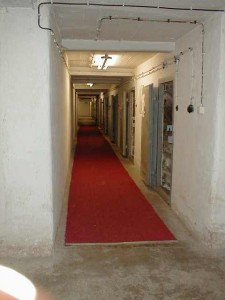
The so called U-Boat
In the 1950s, the Stasi undertook a major construction project, expanding the original building complex with a new building, housing 102 prisoner cells and 120 interrogation rooms. The interrogations took the form of a one-on-one conversation between a prisoner and an interrogator. Under the rubric of psychological terror, the interrogators served as the only contact person for the prisoner, who otherwise was isolated from all other inmates. The guided tour begins with an informational film about the prison. Tour guides then lead visitors into the U-Boot tract, down various corridors of the new building where they can view a typical cell as well as an interrogation room. Other stopping points include the photography room and the courtyard, where visitors can see the Freigangkäfige, the outdoor cages where prisoners exercised in isolation.
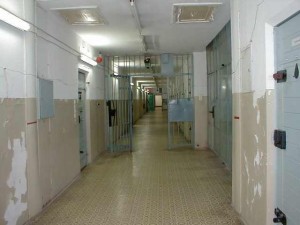
Hallway
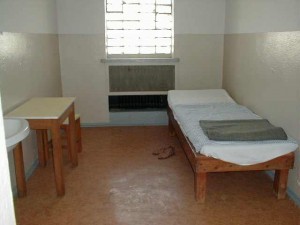
Stasi Cell
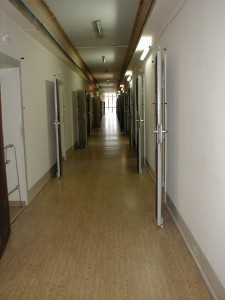
Interrogation Rooms
Unlike the other two sites discussed here, Hohenschönhausen grants visitors insight into the GDR’s political justice system and the ways in which this system of justice impacted individual freedoms. As an authentic site of terror and tyranny, the memorial offers a realistic look at prison conditions and the system of punishment in the GDR. Because it served as a remand prison, it also underscores the tactics that the Stasi used to silence critical voices; many dissidents were imprisoned there for months without ever having been charged of any crimes.
Conclusion
Andreas Huyssen argues that “remembrance shapes our links to the past, and the ways we remember define us in the present. As individuals and societies, we need the past to construct and anchor our identities and to nurture a vision of the future” for “a society’s memory is negotiated in the social body’s beliefs and values, rituals and institutions” (249). In the conscious efforts of civil rights activists to contextualize the Stasi past for present and future generations, they are attempting to place an indelible mark on history, to tell their story, and to ensure that the GDR’s difficult past becomes part of the fabric of 21st-century Germany’s memory and potential for the future. Mary Beth Stein argues that a film such as Das Leben der Anderen succeeded in moving “die historische Aufarbeitung about the East German past beyond the fundamental opposition of victims and perpetrators and the black-and-white rhetoric of the 1990s” (577). Though each of the museums discussed here contributes to the dialog about the GDR past within the national narrative, they have not succeeded in breaking out of the victims versus perpetrators dichotomy.
Each of the three sites strives to inform the national and international public about the legacy of the Stasi. As the official federal office dealing with the Stasi past, the Federal Commission has a duty to present factual information. For the most part, “STASI. Die Ausstellung zur Staatssicherheit” provides visitors with a historical overview of Stasi activity in a variety of situations from political to cultural spheres. The exhibition presents documents in an unredacted format, an overt attempt to appear factual and unmediated. While one cannot dispute the accuracy of the facts, the selection of artifacts and their means of display are a form of interpretation. The site reflects the overall image of the Federal Commission as an objective Aufarbeiter and in so doing positions itself as an omniscient arbiter of its own image. In contrast to the state sponsorship of “STASI. Die Ausstellung zur Staatssicherheit,” the memorials at Normannenstraße and Hohenschönhausen grew out of grass roots activism led by former victims, a circumstance that certainly colors their presentation of the Stasi’s legacy. Normannenstraße and Hohenschönhausen occupy authentic locations and thus afford visitors the opportunity to reflect on the terror mechanisms of the Stasi at the very localities where the terror occurred; these places also have the potential to feed on the emotions of the visitors. Although both facilities portray the Stasi from the victims’ perspective, both also have an intentionally pedagogical agenda to inform the public. A critical distinction between these two sites lies in their approach to the Stasi’s legacy: Normannenstraβe emphasizes the power structures and thematizes the repressive nature of the Stasi; Hohenschönhausen focuses intently on the representation of resistance and opposition on the part of those interned there. At Hohenschönhausen, education about the past is coupled with remembrance.[16]
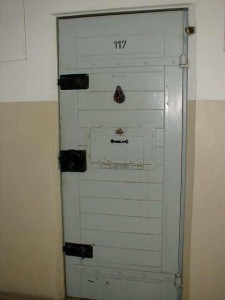
The door to the cell where Jürgen Fuchs was held for nine months
Critics such as Verheyen suggest that the former victims “developed a very distinctive perspective on each of the two memorial sites, insisting on a leading and controlling role that ought to be played by ‘Betroffene’” (184). This continues to be a point of contention as can be seen in the case of former Stasi officers who have objected to their portrayal as perpetrators, insisting that they acted within GDR law.
Even though both Normannenstraße and Hohenschönhausen are products of local initiatives, they also are dependent on federal funding, which often subjects them to broader policy issues pertaining to commemoration and remembrance. In making recommendations for the way that the GDR past should be remembered, the Sabrow Commission suggested that these two institutions should cooperate more closely. Hohenschönhausen’s response is that it does indeed work cooperatively with Normannenstraße, but they object to a merging of the two institutions, precisely because of the distinction between a site of the victims and that of the perpetrators (Sabrow, Erinnerungsorte der DDR 114-15). To be sure, the wealth of documentation offered at all of the sites can provide visitors with significant information to form an educated opinion about that which is displayed. However, no one site on its own can lay claim to representing the entire legacy of the Stasi, for each draws on a specific perspective. Taken as a whole, however, these museums present visitors with a multitude of perspectives from which they then can form their own conclusions. While the museum culture contributes in this way to the dialogue about the national memory narrative in united Germany, it by no means defines it.
References
Ben-Amos, Dan. Afterward. Ben Amos and Weissberg. 297-300. Print.
Ben-Amos, Dan and Liliane Weissberg, eds. Cultural Memory and the Construction of Identity. Detroit: Wayne State University Press, 1999. Print.
Arnold-de Simine, Silke. “Theme Park GDR? The Aestheticization of Memory in post-Wende Museums, Literature and Film.” Emden and Midgley. 253-280. Print.
Aly, Götz. “Wir haben uns alle geirrt.” Die Zeit. 28 May 2009. Web.
Der Bundesbeauftragte für die Unterlagen des Staatssicherheitsdienstes der ehemaligen Deutschen Demokratischen Republik. Information. n.d. Print.
Die Bundesbeauftragte für die Unterlagen des Staatssicherheitsdienstes der ehemaligen Deutschen Demokratischen Republik. Stasi. Die Ausstellung zur DDR-Staatssicherheit. Katalog und Aufsätze. Berlin 2011. Print.
Childs, David and Popplewell, Richard. The Stasi: The East German Intelligence and Security Service. New York: New York University Press, 1996. Print.
Cooke, Paul and Andrew Plowman, eds. German Writers and the Politics of Culture: Dealing with the Stasi. Houndmills: Palgrave Macmillan, 2003. Print.
Dennis, Mike. “The East German Ministry of State Security and East German Society during the Honecker Era, 1971-1989.” Cooke and Plowman. 3-24. Print.
Dueck, Cheryl. “The Humanization of the Stasi in Das Leben der Anderen.” German Studies Review 31.3 (2008): 599-609. Print.
Emden, Christian and David Midgley, eds. Cultural Memory and Historical Consciousness in the German-Speaking World since 1500. Papers from the Conference “The Fragile Tradition”. Vol. 1. Oxford: Peter Lang, 2004. Print.
Erler, Peter and Hubertus Knabe. Der verbotene Stadtteil. Stasi-Sperrbezirk Berlin-Hohenschönhausen. 3rd edition. Berlin: Jaron Verlag, 2008. Print.
Fuchs, Anne, Mary Cosgrove and George Grote, eds. German Memory Contests: The Quest for Identity in Literature, Film, and Discourse since 1990. Rochester: Camden House, 2006. Print.
Fuchs, Anne and Cosgrove, Mary. “Introduction: Germany’s Memory Contests and the Management of the Past.” Fuchs, Cosgrove and Grote. 1-21. Print.
“Gedenkstätte verzeichnet neuen Besucherrekord.” Presseinformation. 04.01.2011. Web.
Gieseke, Jens. Mielke-Konzern. Die Geschichte der Stasi 1945-1990. Stuttgart: Deutsche Verlags-Anstalt, 2001. Print.
—. “Stasi Goes to Hollywood: Donnersmarcks The Lives of Others und die Grenzen der Authentizität.” German Studies Review, 31.3 (2008): 580-588. Print.
—. “Die Stasi und ihr IM.” Sabrow. Erinnerungsorte der DDR. 98-108. Print.
Grafe, Roman, ed. Die Schuld der Mitläufer. Anpassen oder Widerstehen in der DDR. München: Pantheon, 2009. Print.
—. “Wohlfühldichtung für Mitläufer. Das Lügenmärchen vom guten Stasi-Mann.” Grafe. 175-185. Print.
Herrmann, Mareike. “The Spy as Writer: Florian Henckel von Donnersmarck’s Das Leben der Anderen,” Gegenwartsliteratur 7 (2008): 90-113. Print.
Halbrock, Christian. Stasi-Stadt. Die MfS-Zentrale in Berlin-Lichtenberg. Ein historischer Rundgang. Berlin: Christoph Links Verlag, 2009. Print.
Halbwachs, Maurice. On Collective Memory. Chicago: Chicago University Press, 1992. Print.
Huyssen, Andreas. Twilight memories: Marking Time in a Culture of Amnesia. New York: Routledge, 1995. Print.
Knabe, Hubertus. Die Täter sind unter uns. Über das Schönreden der SED-Diktatur. 4th ed. Berlin: Ullstein, 2007. Print.
König, Frank. Die Gestaltung der Vergangenheit. Zeithistorische Orte und Geschichtspolitik im vereinten Deutschland. Marburg: Tectum, 2007. Print.
Koshar, Rudy. From Monuments to Traces: Artifacts of German Memory, 1870-1990. Berkeley: University of California Press, 2000. Print.
Lindenberger, Thomas. “Stasiploitation—Why Not? The Scriptwriter”s Historical Creativity in The Lives of Others.” German Studies Review 31.3 (2008): 557-66. Print.
Nora, Pierre. “Between Memory and History: Le Lieux de Mémoire. Representations 26 (1989): 7-25. Print.
Sabrow, Martin. Ed. Erinnerungsorte der DDR. München: Beck, 2009. Print.
—, ed. Wohin treibt die DDR-Erinnerung? Dokumentation einer Debatte. Göttingen: Vandenhoeck & Ruprecht, 2007. Print.
Stein, Mary Beth. “Stasi with a Human Face? Ambiguity in Das Leben der Anderen.” German Studies Review 31.3 (2008): 567-579. Print.
Stiftung Gedenkstätte Berlin-Hohenschönhausen. 1. Tätigkeitsbericht. Berlin: Stiftung Gedenkstätte Berlin-Hohenschönhausen, 2002. Print.
Verheyen, Dirk. United City, Divided Memories? Cold War Legacies in Contemporary Berlin. Landham, MD: Lexington Books, 2008. Print.
Wilke, Martin. “Fiktion oder erlebte Geschichte? Zur Frage der Glaubwürdigkeit des Films Das Leben der Anderen.” German Studies Review. 31.3 (2008): 589-98. Print.
Notes
1. I am indebted to Dr. Rachel Halverson, Dr. Andrea Fieler and Dr. Caryn Connelly for their insightful reading and helpful suggestions on this manuscript.
2. See Hermann.
3. Gieseke likens Das Leben der Anderen to other recent films that attempt to present history authentically, Sophie Scholl die letzten Tage (2005) and Der Untergang (2003/2004).
4. Even dissidents subjected to constant surveillance by the Stasi such as Wolf Biermann generally approved of the film.
5. For a discussion of the debates and challenges surrounding Germany’s attempt to create a memorialization policy, particularly as it pertains to the use of authentic sites, see König.
6. This new permanent exhibition replaces the previous exhibition housed in a building used by the GDR’s Interior Ministry.
7. The individuals are Hermann Josef Flade, Burkhard Herzel, Gerd Stöcklein, Gabriele Stötzer, Thomas Jonscher and Susanne Hartzsch-Trauer. The exhibition catalog contains their biographical information. The emphasis on private citizens in this instance contrasts sharply with the early exhibition, which focused on more sensational cases such as those of Wolf Biermann and Jürgen Fuchs.
8. Beginning in August 2010, Haus 1 is undergoing renovations; the museum has been moved across the street to Haus 22.
9. On 14 March 1990, the group was recognized legally as the “Religionsgemeinschaft der Zeugen Jehovahs in der DDR”.
10. König points out that the lack of commentary and contextualization can make understanding the displays difficult for those without sufficient knowledge about the Stasi (248).
11. The tour is designed to take 60 minutes (without actually touring Haus 1).
12. After the fall of the Berlin Wall, Hohenschönhausen’s most famous inmate was none other than former Stasi Minister Erich Mielke.
13. Financial support for the memorial site is shared equally by federal and state agencies.
14. This nearly reached an impasse at an event on 14 March 2006, when former officers decried the fact that the memorial portrayed them as perpetrators.
15. I participated in a tour in summer 2003 led by a former inmate who had been victimized by the water torture. He graciously demonstrated the body positions that the prisoners had to maintain throughout the torture. It was obvious, that the memory of the torture was still very vivid in his mind. This is one of the aspects that make a visit to Hohenschönhausen an extraordinary experience. The reconstruction of the U-Boot has been controversial; former Stasi associates maintain that the cells never existed in the form in which they currently are depicted. For details about the controversy see König 259.
16 A poster outside one of his cells reminds visitors of the late Jürgen Fuchs, who was an inmate there for 9 months.
